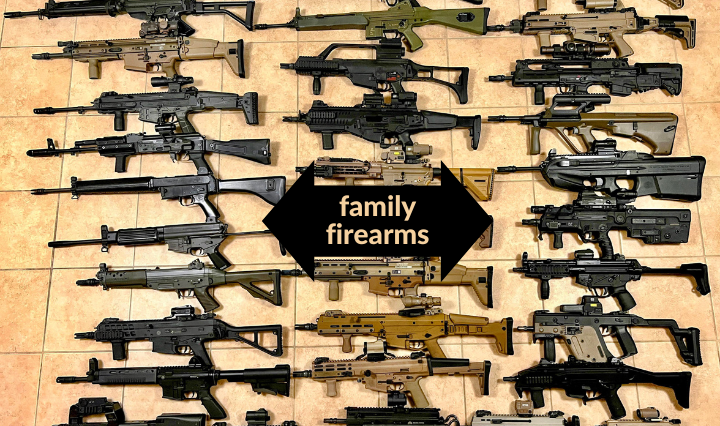Introduction: More Than Just Guns
When you hear the term family firearms, what comes to mind? For some, it’s a collection of heirlooms passed down through generations. For others, it’s about teaching kids responsibility, safety, and marksmanship. Whatever your perspective, one thing’s clear—firearms in a family setting aren’t just tools; they’re a tradition, a responsibility, and sometimes, a rite of passage.
But let’s face it—guns can be a touchy subject. Some folks swear by them, while others wouldn’t touch one with a ten-foot pole. Yet, for families who embrace them, firearms can be a way to bond, protect, and educate. So, how do you balance safety with tradition? What’s the best way to introduce family firearms to the next generation? Buckle up—we’re diving deep!
Why Family Firearms Matter
1. A Tradition Worth Preserving
For many, family firearms aren’t just objects—they’re storytellers. That old hunting rifle in the cabinet? It might’ve put food on the table during hard times. Grandpa’s revolver? Maybe it was a WWII keepsake. These pieces carry history, and passing them down keeps memories alive.
2. Teaching Responsibility Early
Handling a firearm isn’t child’s play (literally). But with proper guidance, kids can learn discipline, focus, and respect for weapons. Think of it like teaching a teen to drive—scary at first, but essential for their growth.
3. Bonding Over a Shared Skill
Ever been to a shooting range with family? There’s something uniquely satisfying about hitting bullseyes together. Whether it’s hunting, target practice, or competitive shooting, firearms can bring people closer.
Safety First: Handling Family Firearms the Right Way
You wouldn’t hand a chainsaw to a toddler, right? Same logic applies here. Before anyone touches a firearm, they need to know the golden rules:
The Four Commandments of Gun Safety
- Treat every gun as if it’s loaded. Even if you think it’s empty, check again.
- Never point the muzzle at anything you don’t intend to shoot. Walls, feet, pets—all off-limits.
- Keep your finger off the trigger until ready to fire. No exceptions.
- Be sure of your target—and what’s beyond it. Bullets don’t magically stop mid-air.
Storing Family Firearms Safely
- Lock ‘em up. Gun safes or trigger locks prevent accidents (and theft).
- Ammo separate from firearms. Because double safety never hurts.
- Educate everyone in the house. Even if they don’t shoot, they should know basic safety.
Passing Down the Legacy: Introducing Kids to Family Firearms
So, when’s the right age to start? Well, that depends. Some kids are ready at 10; others might need to wait until their teens. Here’s a quick guide:
Age-Appropriate Firearm Introduction
- Ages 6-10: Start with toy guns (Nerf, BB guns) to teach muzzle discipline.
- Ages 10-14: Supervised .22 rifle sessions—low recoil, easy handling.
- Teens & Up: Gradual introduction to larger calibers, always with an adult present.
Making It Fun (and Educational)
- Set up a backyard pellet range. Low stakes, high fun.
- Turn cleaning into a lesson. Maintenance is part of the responsibility.
- Reward progress. Hit a target three times in a row? Ice cream time!
Common Myths About Family Firearms
Let’s bust some misconceptions, shall we?
Myth #1: “Guns in the house make it unsafe.”
Reality: Proper storage and education drastically reduce risks. It’s like saying cars are unsafe—only if misused.
Myth #2: “Kids can’t handle firearms responsibly.”
Reality: With the right training, kids often outperform adults in discipline.
Myth #3: “Family firearms are just for protection.”
Reality: They’re also for sport, history, and skill-building. Not every gun is a “home defender.”
About The FAQs Family Firearms
Q: How do I start a conversation about guns with my family?
A: Keep it casual. Maybe say, “Hey, I’d love to teach you how to safely handle Grandpa’s old rifle. Interested?”
Q: What’s the best first gun for a child?
A: A single-shot .22 rifle—light, easy to manage, and great for fundamentals.
Q: Are antique firearms safe to shoot?
A: Sometimes, but have a gunsmith check them first. Old doesn’t always mean functional.
Conclusion: A Legacy in Your Hands
Family firearms aren’t just metal and wood—they’re heirlooms, teachers, and sometimes, lifesavers. Whether you’re preserving a century-old shotgun or teaching your kid their first shooting stance, the key is respect. Respect for the weapon, for safety, and for the tradition it represents.

